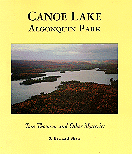


|
Canoe Lake, Algonquin Park: Tom Thomson and other Mysteries.
S. Bernard Shaw. Subject Heading:
Grades 10 and up / Ages 15 and up. ***/4
|

excerpt:
"By Algonquin Park standards, Canoe Lake is not an especially large body of water, and there are many others in the park that boast a more dramatic physical setting. It does, however, possess its own indefinably powerful character. As you paddle out of the sheltered bay from the Portage Store and look northward up the main reach, you immediately feel a sense of high northern remoteness - a magic also experienced by many famous Canadian painters. Past some modest pine-clad islands in the foreground, the blue waters extend to distant shores fringed with dark green pine, spruce and balsam. Beyond, maple forests climb rolling hills to the crest of the Algonquin highlands."This book will appeal to a wide readership because, through various novels, Algonquin Park is familiar to readers throughout North America. As additional drawing cards the names "Grey Owl" and "Tom Thomson" will attract other interested readers.
One example of the many fascinating stories in this book is the account of David Gilmour's amazing attempt to drive logs from his Canoe Lake timber holdings to his mill at Trenton - a 450-kilometre journey. Author S. Bernard Shaw collaborated with geographer and writer Gary Long to describe the feat, which took bold planning and an enormous amount of money because it involved "damns, canals and an ingenious mechanism known as the tramways." Photographs and maps - generously used throughout the book - draw the reader completely into the heart of the scheme. There are descriptions of the many devices used, including special boats called pointers, and weird-looking amphibian "alligators" which were "essentially steam-powered winching tugs, flat-bottomed with side-mounted paddle wheels." Roads, railways and telephone lines were constructed for the project as well, but, unfortunately, in the end David Gilmour's ambitious endeavour had to be abandoned.
Another personality described in the book is Taylor Statten who, with his wife, started two popular camps on Canoe Lake - Camp Ahmek and Camp Wapomeo, both of which are still in operation. Some well-known former campers and counsellors include Pierre Trudeau, David Lewis, and Barbara Ann Scott.
Yet another celebrity connected with the history of Canoe Lake was Grey Owl, the Englishman who impersonated an Aboriginal, preaching and writing about conservation in the forests.
Tom Thomson of Canada's famous Group of Seven landscape painters is probably the best known of all residents of Canoe Lake. The author has gone to great lengths to bring out the many viewpoints, theories and contradictions about Thomson's life and tragic death there. Appendix B includes reproductions of Tom Thomson documents.
These are but a few examples of subjects included in Canoe Lake, and there are many more. The author has captured the flavour of Algonquin Park and succeeded in almost realistically transmitting its pine-scented atmosphere to the reader. Most enjoyable.
Recommended
Joan Payzant is a retired teacher-librarian of Dartmouth, Nova Scotia.

To comment on this title or this review, send mail to cm@umanitoba.ca.
Copyright © 1996 the Manitoba Library Association. Reproduction for personal use is permitted only if this copyright notice is maintained. Any other reproduction is prohibited without permission.
Published by
The Manitoba Library Association
ISSN 1201-9364
AUTHORS |
TITLES |
MEDIA REVIEWS |
BOOKSHELF
BACK ISSUES |
SEARCH |
HOME